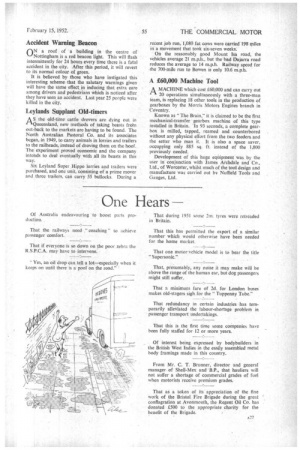Passing Comments
Page 28

Page 29

If you've noticed an error in this article please click here to report it so we can fix it.
Similar Chassis Vary in Weight
CHASSIS makers arid, bodybuilders now co operate much more fully than was the case only a few years ago. This has resulted in a considerable improvement in the way of standardizing both chassis and bodies in respect of those dimensions which are pertinent to both. In fact in many instances bodies do not now have to be built for individual chassis but can be jigged separately and thus become reasonably interchangeable.
There is one factor, however, which worries some bodybuilders. This is the variation sometimes found in the weigh( of chassis of the same make. and model. Differences as high as 4 cwt. have been found, and with legal requirements so exacting. the problem to be faced is how this weight, or some of it, can be saved on bodies which should, in the normal course, be identical. Presumably, some of the additional weight can be blamed on to outside contractors, but there appears to be a need for greater supervision in this matter.
Aiding Road Transport in Europe
A N overall co-ordination of the European network r-kin regular motorcoach services is being sought by the Inland Transport Committee of the United Nations Economic Commission for Europe. The object is to link up services on major route centres in such a way as will enable the traveller by these means to move more widely and freely.
This forms part of the difficult work of establishing the future trend of transport policy to be adopted jointly by European countries. During January, an international convention to facilitate the crossing of frontiers by goods vehicles and their contents was signed by Belgium, France, Italy, Luxembourg, The Netherlands, Norway, Sweden and Switzerland.
Incidentally, the committee recorded a general upward trend in the volume of road, rail and water traffic in Europe, but statistical research had revealed a lack of information concerning goods transport by road, which is considered to be a prerequisite to the formulation of a general transport policy.
Accident Warning Beacon
rINT a roof of a building in the centre of \-"Nottingham is a red beacon light. This wilt flash intermittently for 24 hours every time there is a fatal accident in the city. After this period, it will revert to its normal colour of green.
It is believed by those who have instigated this interesting scheme that the salutary warnings given will have the same effect in inducing that extra care among drivers and pedestrians which is noticed after they have seen an accident. Last year 25 people were killed in the city.
Leylands Supplant Old-timers
A S the old-time cattle drovers are dying out in "Queensland, new methods of taking beasts froiri out-back to the markets are having to be found. The North Australian Pastoral Co. and its associates began, in 1949, to carry animals in lorries and trailers to the railheads, instead of droving them on the hoof. The experiment proved economic and the company intends to deal eventually with _all its beasts in this way.
Six Leyland Super Hippo lorries and trailers were purchased, and one unit, consisting of a prime mover and three trailers, can carry 55 bullocks. During a recent job run, 1,080 fat cows were carried 198 miles in a movement that took six-seven weeks.
On the reasonably good Mount Isa road, the vehicles average 21 m.p.h., but the bad Dajarra road reduces the average to 14 m.p.h. Railway speed for the 700-mile run to Bower, is only 10.6 m.p.h.
A £60,000 Machine Tool
AMACHINE which cost £60,000 and can carry out
• 20 operations simultaneously with a three-man team, is replacing 18 other, tools in the production of gearboxes by the Morris Motors Engines branch in Coventry.
Known as "The Brain," it is claimed to be the first mechanical-transfer gearbox machine of this type installed in Britain. In 93 seconds, a complete gearbox is milled, tapped, reamed and counterbored without any physical effort from the two feeders and the setter who man it. It is also a space saver, occupying only 885 sq. ft. instead of the 1,800 previously needed.
Development of this huge equipment was by the user in conjunction with James Archdale and Co,, Ltd., of Worcester, whilst much of the tool design and manufacture was carried out by Nuffield Tools and Gauges, Ltd.




















































































